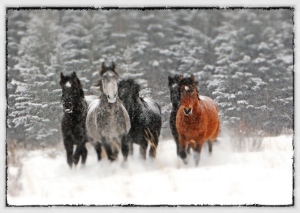By Jordana Divon | Daily Brew
Most Captured Wild Horses Sold Off to Slaughter
With the highest cowboy boot per capita ratio in the country, Alberta would seem the most natural place in Canada for wild horses to roam.And it is. The Wild Horse of Alberta Society estimates that hundreds of the magnificent creatures live freely and openly in the province’s forests, with the government allowing for a certain number of horses to be humanely captured each year.
But, as the Calgary Herald reports, the number of captures recently hit a record high and the increase has the Society concerned that the wild horse population will disappear if it continues at this rate.
Between December 2011 and February 2012, 216 horses were taken from the wild out of an allotted 237 permits issued per season. In comparison, an average of 30 horses were captured per year over the last half decade.
Statistics on the number of horses that live in the wild vary. While Sustainable Resource Development spokesperson Dave Ealey said the official tally stood at 778 horses — down from 1,000 before this year’s roundup — Bob Henderson, president of the Wild Horse of Alberta Society claimed the number is closer to somewhere between 500 and 550.
What’s most troublesome to Henderson, however, is that he claims 90 per cent of those horses are sent straight to the slaughterhouse for their meat.
“These horses are part of our natural heritage,” Henderson told the Herald.
Henderson told the paper he has no problem with people taking the horses for adoption purposes, but he said the province doesn’t follow up with the animals once they’ve been taken, meaning people can ultimately do anything they want with them.
“We really don’t follow it. It’s basically their property once they’ve captured the horses,” Ealey admitted to the paper.
“They are entitled to the horses for their particular purposes because, basically, they’re private property then. A lot of the horses in the past, we know have gone to rodeo animals, stock animals, some of them have gone to the food industry, along with domestic.”
Part of the justification for this practice, said Ealey, is that the horses are considered “feral,” having escaped or being released by their owners, while others are the offspring of those horses.
He also said the horses pose a risk to humans when they cross roadways and that they eat the grass meant for other wildlife species.
Henderson firmly disagrees with both arguments, writing in an open letter on the Society’s website that several leading archaeologists, biologists and geologists believe the horses to be indigenous to North America, and secondly, that there is plenty of grass to go around for everyone.
“They used horses to open this whole country. They should mean more to us than someone’s opinion that they’re feral and stray and they don’t belong out there,” he added.
If anything, said Henderson, Alberta has a responsibility to protect its heritage. He noted that Mounties observed thousands of horses in the wild when they first came west and he hopes the government does something before the entire population becomes a historical footnote.










No comments:
Post a Comment